By Warren McCullough of CompactRV.net.au
Back in our early campervanning days our fridge and even our (outdoor) lights were powered by LPG, while water was pumped manually to our kitchen sink. There was no pressing need to know too much about batteries to maintain a 12V electricity supply – instead, we carried a spare gas bottle, parked on level ground to keep the fridge cold, and became adept at replacing fractured mantles in LPG-powered lanterns.
Fast forward to modern times: The availability of large capacity batteries and affordable solar panels, along with advances in LED lighting and refrigerator technology, means 12V electrical sustainability is now readily achievable, providing reliable off-grid power for a wide range of campervan and motorhome (let’s just call them motorhome) appliances.
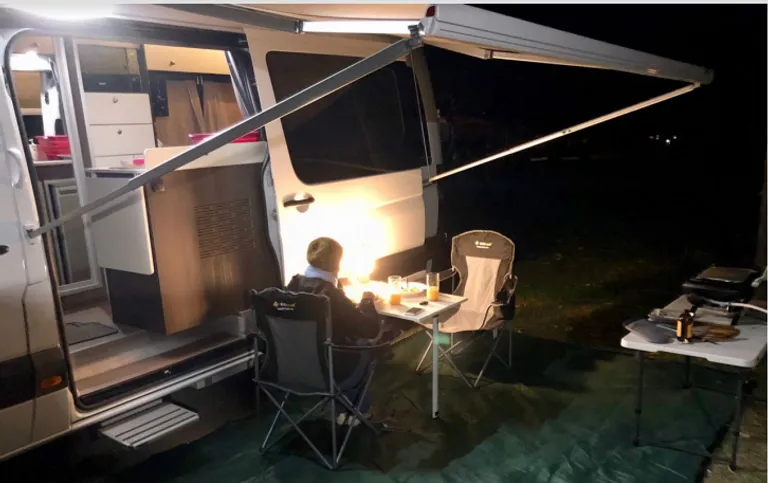
Our van’s fridge, lights and water pump are now powered by electricity and we use LPG only for our cooktop and hot water heater. Our vehicle’s space heater is fuelled from our main diesel tank, but requires 12V electricity to (initially) ignite the fuel and then keep the fan running.
New motorhomes at the leading edge have gone one step further and are now equipped with electrical systems capable of powering portable domestic appliances, such as coffee machines and induction cooktops, through an inverter that converts the built-in 12V DC electricity supply to 240V AC.
At the heart of all 12V electrical systems are batteries that store electrical energy. In the case of our van, our 12V appliances are powered by two rechargeable 100 amp-hour (AH) deep-cycle Absorbent Glass Mat (AGM) batteries. These batteries can be recharged from current generated by:
- A 150W solar panel mounted on the roof
- A 200W portable solar blanket;
- The vehicle alternator
- A 240V power supply.
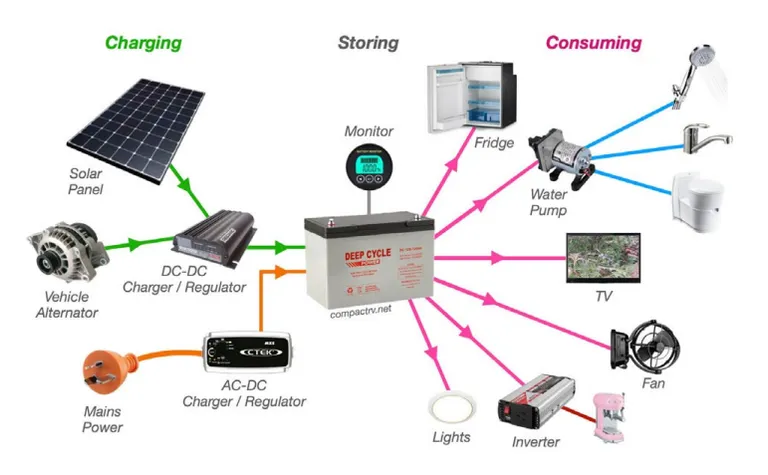
Energy-sustainable ‘free camping’, without dependence on an external power supply, requires enough on-board battery capacity to power our van’s 12V appliances for the period of our stay, along with the ability to recharge the batteries as their energy reserve is depleted. The question is, do we have enough battery capacity and recharging capability to keep our appliances running?
Understanding the world of batteries and recharging options can be something of a challenge and it is not always straightforward to determine:
- The usable capacity and longevity of the battery's energy reserve
- How much power our appliances draw from the batteries each day
- The electrical system’s capacity to recharge the batteries.
The net combination of the above factors determines how long we can live off-grid while maintaining a sustainable supply of 12V electricity. Exact values for each of these criteria can be difficult to determine due to a number of variables, including weather conditions, appliance usage patterns and battery recharging sources.
Understanding the parameters of any 12V electricity supply can help in assessing and estimating the potential for off-grid living. So, let’s kick off by looking at batteries and their role in powering 12V appliances.
Batteries
Batteries are devices that convert chemical energy into electrical energy. Early batteries (circa 1800s) used copper and zinc immersed in salt water to create energy that could be converted into electricity (there is also some archeological evidence of similar devices being used thousands of years ago in Middle Eastern civilisations – although the motorhomes of that era appear to have been fairly basic!).
In the modern world, batteries are ubiquitous. They are the hidden energy source powering a myriad of portable electronic devices and the 12V appliances in our motorhomes are simply larger portable devices that require larger batteries. These batteries still depend on a chemical reaction to create electrical energy.
Motorhome batteries are the rechargeable deep-cycle type, designed to provide a steady supply of energy over a long period of time. They are not to be confused with engine-starting batteries, which are designed to supply a large burst of energy over a very short period of time.
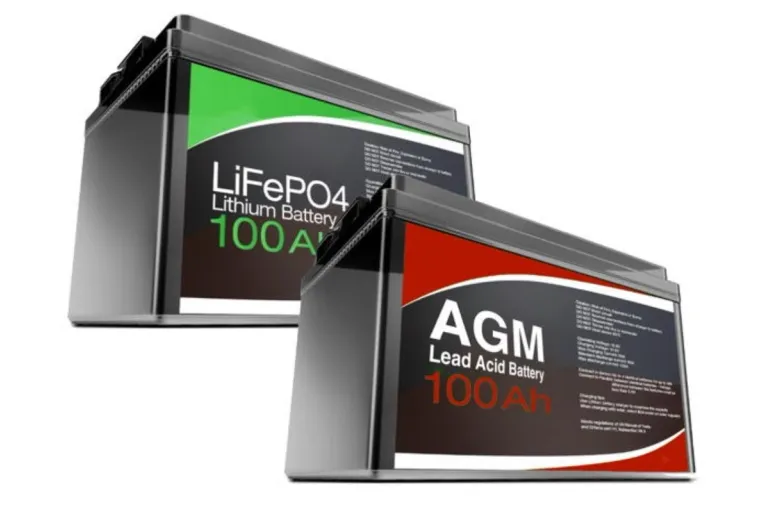
There are two types of deep-cycle batteries commonly used to power electric appliances in motorhomes:
- Sealed Lead-Acid batteries (SLA)
- Lithium-Iron-Phosphate batteries (LiFePo4 or LFP)
Many will be familiar with older ‘wet’ lead-acid batteries, containing lead plates immersed in liquid sulphuric acid. Back in the day, these batteries were commonly used to crank car engines. I recall regularly checking the level of the sulphuric acid in the cells of my car’s starter battery, topping them up with distilled water when required.
The lead-acid batteries widely used in campervans and motorhomes today are Absorbent Glass Mat (AGM) batteries. They are sealed units, with the acid component (the electrolyte) absorbed into glass-fibre matting between the lead plates. Importantly, for use in closed indoor environments, they don't liberate noxious gases when recharging.
The new kids on the rechargeable battery block are Lithium-Iron-Phosphate batteries (LiFePO4 or LFP), similar to, but not the same as the rechargeable Lithium-ion batteries used in our phones and other mobile devices.
Lithium-Iron-Phosphate batteries (commonly referred to simply as lithium batteries) are able to supply a more constant voltage over a longer period of time than lead-acid batteries; they recharge far more quickly and are only a fraction of the weight of lead-acid batteries – all important factors when considering options for your motorhome. Unfortunately their upfront cost is relatively steep.
Measuring Longevity
Do we have enough battery power? How much stored battery energy do we need to power appliances in a motorhome? How long will our batteries last? Before we can answer any of these questions we need to understand how our batteries’ electricity supply and our appliances’ electrical appetite is measured.
Electricity supply is measured in volts and amps. A neat analogy to help understand these terms is a comparison with water flowing through pipes:
- Voltage (measured in Volts) is equivalent to the pressure pushing water through the pipes
- Current (measured in Amperes, or Amps) is equivalent to the flow rate of the water through the pipes
- Resistance (measured in Ohms) is equivalent to the effect of the diameter of the pipes, which, if too narrow, might restrict the flow of water.
The electrical current flowing from our batteries is measured in amps (A) and battery capacity is rated in amp-hours (Ah).
In theory, a 100 Ah battery can continuously supply 1 Amp of electrical current for 100 hours, or 2 Amps for 50 hours, 4 Amps for 25 hours, etc, until fully discharged. However, as discussed later, your batteries should never be fully discharged.
How Much Energy Is Left?
The level of stored energy remaining in a battery at any given time is known as the State of Charge (SoC).
The SoC of an AGM battery can be estimated from a voltage reading, since the battery’s voltage falls in a relatively linear fashion as the level of stored energy declines. This is not so for lithium batteries, as their voltage output remains relatively constant across their period of discharge (see graph below.)
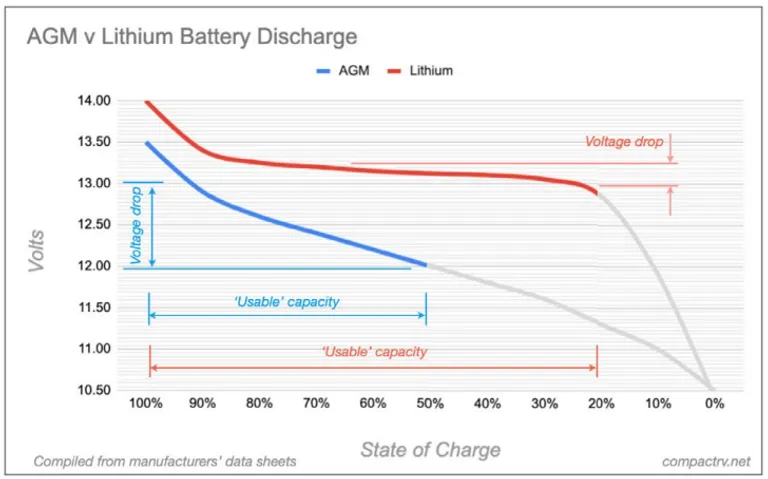
It is important to understand that SoC is accurately measured when there is no load on the battery, and there hasn’t been a load for a couple of hours. With a load on an AGM battery (e.g. fridge running), the voltage will display as less than the actual SoC. When the battery is charging (e.g. solar panel input) the voltage meter will display a higher voltage than the actual SoC.
All batteries have discharge/recharge limitations. AGM batteries’ SoC shouldn’t be allowed to drop below 50% capacity. In the case of a 100 Ah battery, this equates to a usable 50 Ah capacity. Discharging below this 50% SoC will reduce the long-term life of the battery.
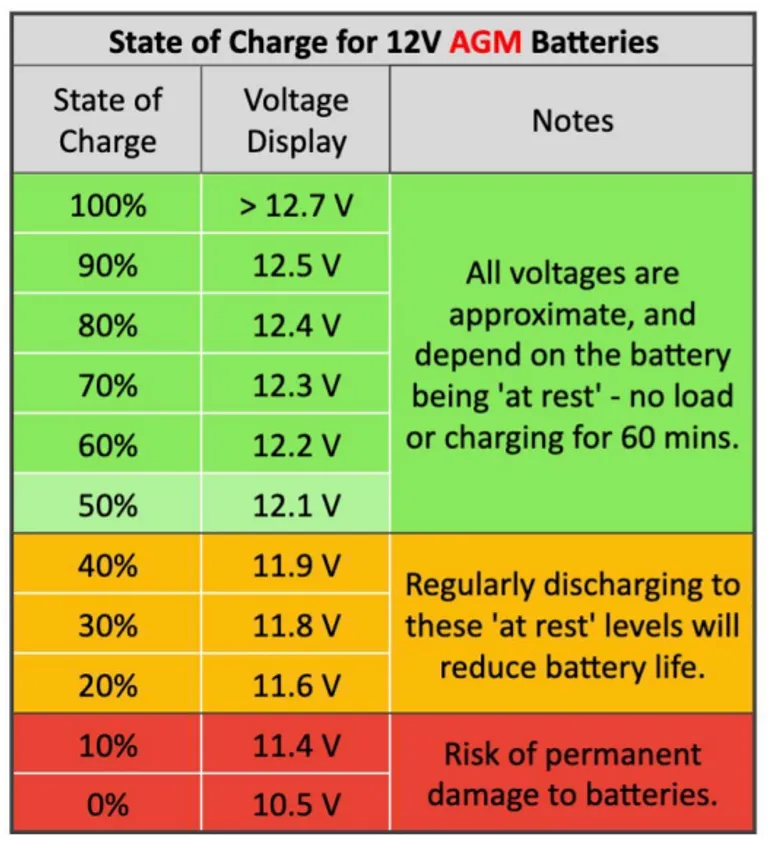
An AGM battery that is allowed to regularly drop below 50% SoC can have its lifetime serviceability reduced to 100-250 recharge cycles, compared to over 500 cycles in a well-maintained charging regime.
An indication of having reached this 50% level of discharge is provided when your digital voltmeter, usually located in an electrical control panel, indicates that stored battery energy has dropped to 12.1V when ‘at rest’ – when there are no appliances drawing current and no charging input (see the chart).
By comparison, the voltage of a lithium battery remains relatively constant as it discharges, and can be discharged to 20% capacity. Lithium batteries also recharge much more quickly than AGM batteries, and have a lifespan of over 1500 recharging cycles (and considerably more if kept to a 50% discharge limit rather than 80%).
As noted, lithium batteries maintain a more constant voltage output over their discharge period, so a simple voltage measurement won't provide too much information relating to the battery’s overall state of charge. The SoC meters used with lithium batteries use a Coulomb Counting algorithm, measuring current flow in and out of the battery and displaying the result as a percentage SoC.This measurement does not rely on the battery being ‘at rest’ to provide an SoC estimate.
In the Real World…
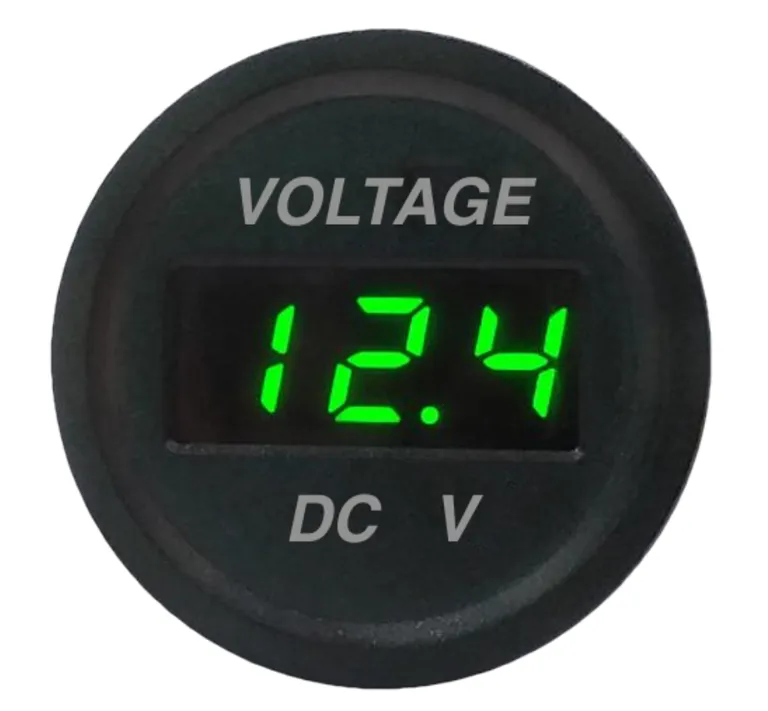
All the above is good in theory, but where does it leave us when the rubber hits the road - or the thongs hit the sand at our favourite off-grid camping location?
The AGM batteries in our van are now over four years old, which is getting towards their more senior years.
When camped in the one location for three days last Spring I regularly checked our voltmeter readings before sunrise each morning, with the batteries being recharged from only a 150W rooftop solar panel the previous day. The main load drawing energy from the batteries was the fridge, but we were also using the water pump, LED lights and TV screen at night. After the first night our voltmeter read 12.4V and after the second night 12.3V, but after the third night it was just 12.1V.
Back when the batteries were new the voltmeter rarely dropped below 12.5 V when under load at night. Remember that these figures aren’t true SoC – turning the fridge off will immediately jump the voltage reading up from 12.3 to 12.5 V. The SoC after solar recharging and a few hours ‘rest’ is still 12.8V.
I am okay with that, given it is unusual for us to stay in the same unpowered site for more than a couple of nights. Once we start the van up to move on, the alternator feeds current into the batteries at a much higher rate than the solar panel.
Back home, when our batteries are fully charged, the solar panel is in full sun and there are no appliances running, our voltmeter reads between 13.2 and 13.7 volts during the day, depending on the time of day, angle of the sun, etc. This reading can be up to 14.6V if the batteries are recharging from a low level of charge. Before sunrise the reading is 12.8V.
Would we be better off with Lithium batteries? I guess it would be comforting to see the voltmeter sitting on a steady 13V every night when we have all our appliances running. And, more importantly, knowing that the batteries would be charged in two hours the next day rather than eight hours. But in reality, that wouldn't be keeping the fridge any colder, or making the lights too much brighter. Not for the first couple of days at least!
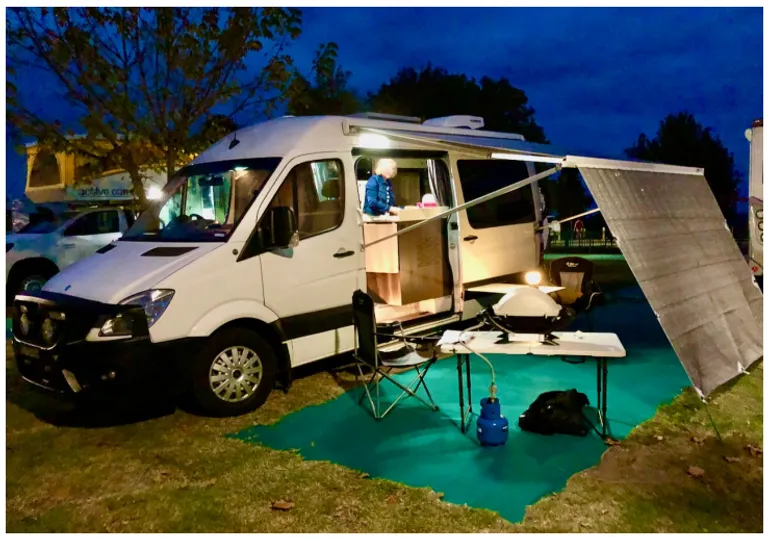
In the not too distant future, once we start to see our battery voltage regularly dipping down to 12.1V when under load and our maximum SoC sitting at around 12.3 V, then we will be looking at a lithium upgrade. Or, if I was planning on a long trip without too many nights in powered sites, I might be prompted to dig deep into the wallet to pull out the lithium cash. But that would only be after some careful research, because there are lithium batteries and lithium batteries. In the meantime, our AGM batteries are doing all that we need.
Next time we’ll look at appliance power consumption and the impact of appliances on battery storage and recharging capacity. Don’t miss it!

